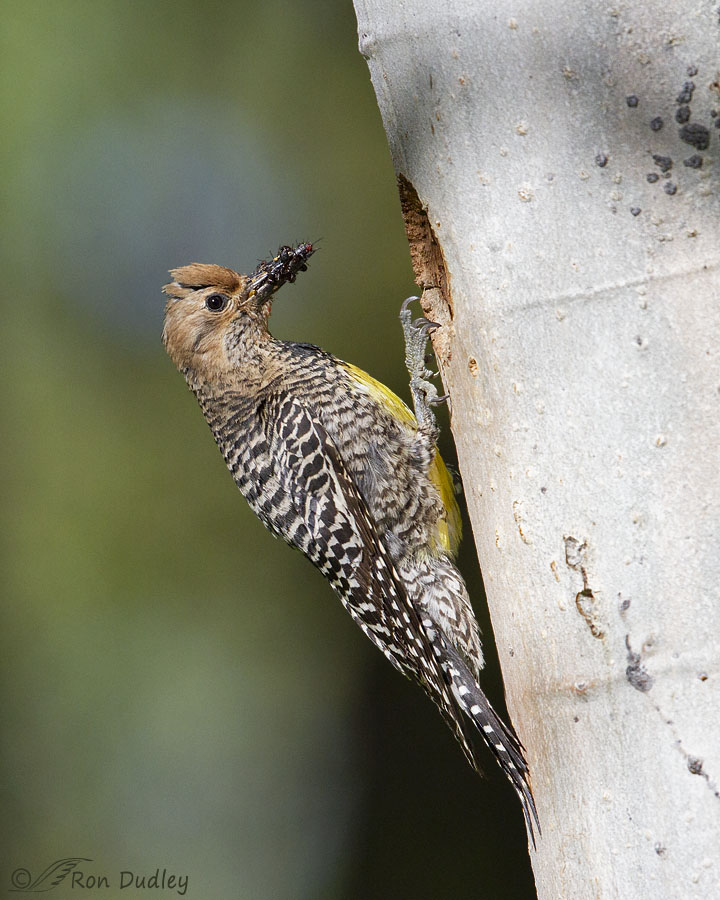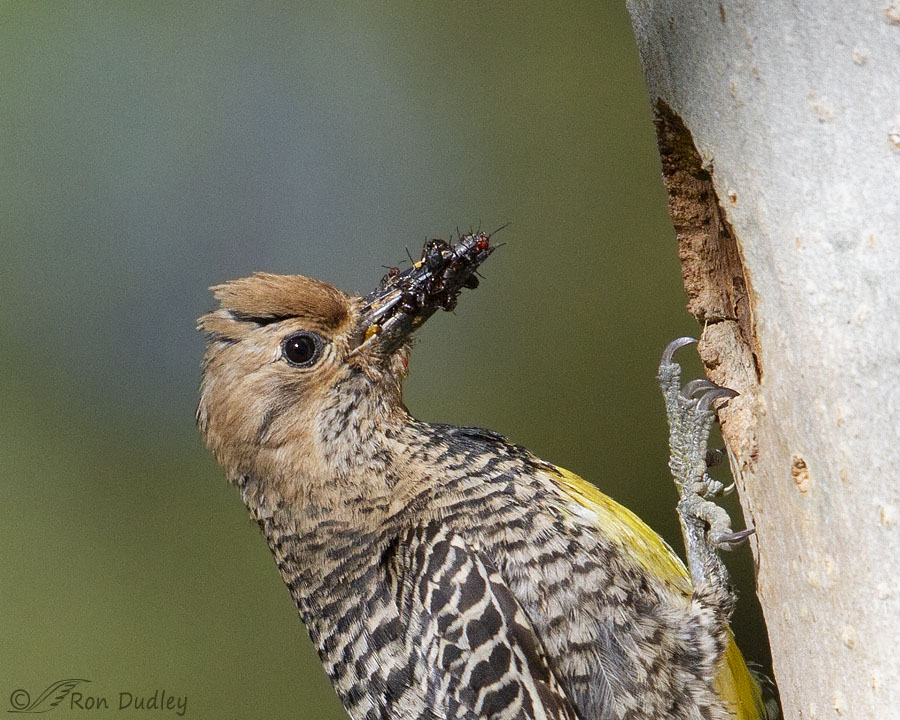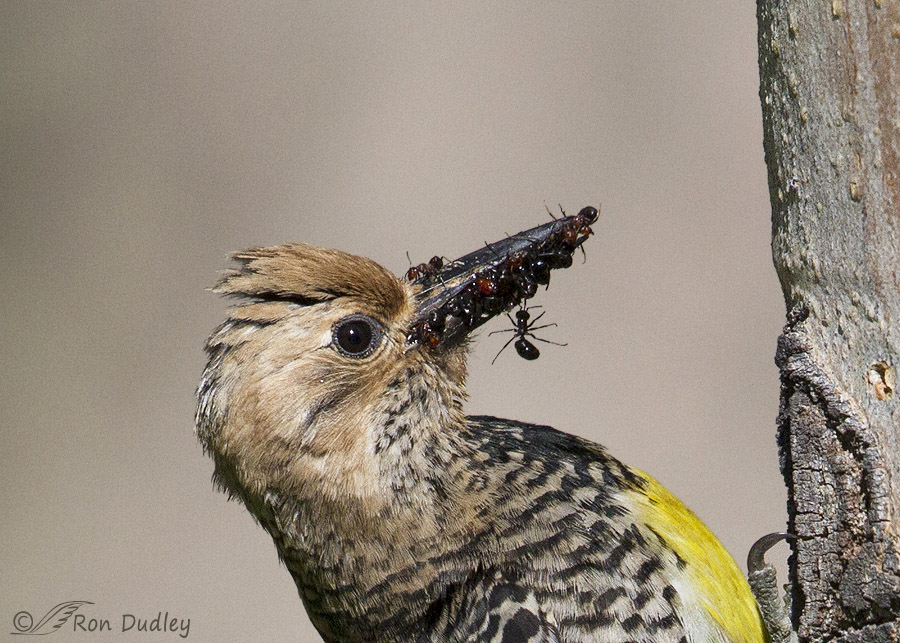It gives me The Willies to think that most of these ants are still alive because I know from experience that they have a nasty bite..
- I’ve never posted this photo before in part because it was significantly underexposed in camera. In fact I’d never even opened the image. But when I finally opened it last night (it was taken 6 years ago) and then worked it up it was surprisingly sharp and detailed so I actually liked it.

1/3200, f/6.3, ISO 640, Canon 7D, Canon EF 500mm f/4L IS II USM, not baited, set up or called in
This female Williamson’s Sapsucker has a beak full of ants for her chicks in the nest. Here she has landed at the cavity entrance and is waiting for her mate, who is still inside the cavity, to exit before she enters. I photographed this predictable routine many times near the border of Montana and Idaho over a period of two summers.
The number of ants carried by the parents each trip varied tremendously. Sometimes I could only see a few ants outside their bills although there may have been more of them inside that I couldn’t see. Other times there were so many ants I could barely see the bill of the parent. I’ve seen smaller and larger ant loads than this one.
It made me wince when I first realized that most of the ants were still alive. Anyone who’s been bitten by ants knows why. I can’t imagine what would prevent them from biting the tongue and even the face of the sapsuckers.
Here it may be a little difficult to positively identify the insects as ants so…

I cropped tightly on the bird in the same photo in an attempt to make it a little easier. If it still isn’t obvious…

here’s another tightly cropped photo of her with a different and even larger load of ants. Conveniently one of them is hanging down against the homogenous background making it easy to see that they’re ants. Pretty big ones too. Another ant appears to be loose and running around freely on the top front of her bill.
I’ll never forget being bitten by large ants like these in Montana when I was a little kid. It was always painful and the duration of the pain was far from brief. During nesting season adults and youngsters of this species eat ants almost exclusively. In fact Williamson’s Sapsuckers have the highest dependence on ants as food of any North American woodpecker.
So I’m thinking that sapsuckers must have some kind of defense against “the revenge of the ants” but if they do I have no idea what it might be.
Ron
- Note: The scientific name of Williamson’s Sapsuckers is Sphyrapicus thyroideus. As someone who has recently endured thyroid surgery I’m curious as hell to know why thyroideus was chosen as their species name. I tried researching it but came up empty. The Greek “thyreoeides” apparently means “shield shaped, like a door” but apparently I’m not smart enough to make the connection with this species of sapsucker. Any guesses anyone? The only thing I can think of is the similarity of the opening of their nest cavity to a door but that possibility seems more than a little remote…
- Addendum: Facebook friend Muffy S. Gately found a reference (Latin For Bird Lovers) that says “thyroideus” may refer to the black breast patch of the female sapsucker.


Nice shot. Good background.
Thanks, Jean.
Wonderfully sharp shots, Ron! She’s a beauty. I wonder if those raised feathers along her forehead (I don’t know if this species qualifies as having a crest) indicate possible discomfort with the ants.
My mom and I had a huge fight when filling out my first HS class list. She INSISTED that I take typing and I wanted to take an extra science class. She won and I’m forever grateful. Wish I had taken shorthand too.
Our part of the city must have been built on a giant anthill. Fortunately, they’re the little guys, but I’m still not a fan.
Marty, those “little guys” nest under my front step. Every year in the spring they come out by the kabillions.
Me too on typing – swore I’d NEVER use it – HA!
My wife at the time was excellent at typing. If I needed something typed she did if for me. Didn’t help much after we were divorced…
I blow up bigger than a barrage balloon when an ant fangs me so both the Sapsucker and her chicks are much tougher than I am (not difficult but still).
I am so very glad that you saved and shared this photo – even if the skin on the back of my neck is still crawling.
It kind of gives a person the heebie-jeebies doesn’t it, EC.
It’s late but I just got the chance to log in. Williamson’s Sapsuckers are always a treat to see. We don’t have them here in the Willamette Valley so I don’t get as many chances to see them as I would like.
Let me add just a bit about the name. As noted, the Latin name does refer to a shield and is a reference to the black breast of the female. John Cassin is responsible for giving this name in the early 1850s. He based this on some specimens of the female and gave the common name of Black-breasted Woodpecker. Because the male and female look so very different, they were considered two different species until many years later. Once it was finally figured out that these two very different plumages were of the same species, only one name could be used and since the female was identified first, thyroideus was used for the entire species. The genus designation has changed over the years. I believe that Cassin first assigned the name Picus thyroideus to the specimens he had.
Fascinating background, Dan. I knew that early ornithologists thought males and females were different species but I never associated that with the eventual species name for them.
I am glad you decided to give these another look. They are great. The close up with the dangling ant is wonderful.
As you might of heard I had my own recent run in with ants. I must be tasty, everything bites me and then my body over reacts. Boy, what we endure for a photo!
Yeah, I heard about your little ant escapade this morning, April. You of all people!
Ron, I’m amazed and grateful that you kept these photos even though you didn’t think they could be made into the high quality pictures we see. They are sharp, not obviously grainy, and show details I’ve never seen elsewhere.
You must be right about the defense against ant bites. Parents might endure almost anything to feed their newly hatched babies, but would they feed those babies still fighting, biting live ants? Not likely!
Nancy, It would be interesting to have a video camera inside the nest cavity. I can imagine dozens of loose ants scurrying around and the chicks competing to see who could pick off each one first.
Ron. I think she looks mad. Maybe her mate is taking too much time to leave and let her get rid of her load. Thanks for capturing the ant hanging down. Diana
She might be a little impatient with him. Notice that she’s leaning a little to her left to give him room to make his exit. In some of my shots like that one I can see his bill sticking out of the entrance.
These are outstanding and educational photos Ron. That Sapsucker looks very calm and relaxed waiting for her turn to enter that cavity. Makes me think that maybe she is immune to the ants bites. I too have often wished that I had taken Latin, but as for typing, I learned to type in the Navy when they made me a Radioman. Had to know how to type very fast in order to take Morse Code messages. Even today at 82 I can type 80 wpm or more.
Thank you, Everett. I eventually became a pretty good typist but it took me a long time and the process was far more painful than it had to be. All because I dropped that class…
Excellent…up close and personal photos! Would never want an ant that close to my eye. Scientific names have always intrigued me. I’ve never forgotten the intense hours of studying and memorizing Latin in high school but how it has paid off…from nursing to horticulture to birding. Once you know it you can decipher those botanical names and know why plants were given the name they sport. So that ‘thyroideus’ (thyreodea–Latin) makes perfect sense when you look at the bird. Wonder how many schools have that old requirement of having Latin as a ‘must class’ for certain college requirements any more…
Kathy, I’ve always said that I have two regrets about the classes I took and didn’t take in high school.
I wish I’d taken Latin. It would have helped me tremendously in both college and in my teaching career.
I wish I’d taken typing. I actually took it for a short time but for a stupid reason. The teacher, Miss Schwingel, let her students listen to the World Series during class (she was a sports fanatic and eventually married a coach). So I took her class until the World Series was over and then dropped it.
You can’t imagine the pain I went through trying to learn how to type on my own when computers eventually became a necessity. Stupid, stupid, stupid!
They don’t even offer Latin in many school systems now. Too bad as it certainly helped with English and scientific names.
Kathy, I, too, had Latin in the Quaker high school I attended for a year. I kind of enjoyed it even then and it certainly has been useful over the years! I doubt it is taught now…unless by such schools that are chosen for their offspring by educationally-minded parents.
I rescued a camper from a fire ant bed. I got bitten A LOT. To the point they had to give me prednisone. Camper was okay with a few bites because they swarmed off her onto the new threat. Me. I have hated ants ever since. Darn things hurt!!!!
Arwen, I’ve never been bitten by fire ants but I’ve sure heard stories. These guys hurt more than enough.
I have a love/hate relationship with prednisone. That stuff very nearly killed one of my cousins.
Fire ants do not bite. They sting and somehow they communicate between themselves to swam on you and then sting all at once. I believe formic acid is injected with the sting but have never checked out that belief.
Haven’t the foggiest! But I’ll look forward to all the Posts to see if anyone can come up with definitive answers.
Great photos, by the way!
I think we have the answer already, Joanne. See my addendum and the comment from Dave Brooks.
These are incredibly successful ant capturing displays. In that last shot it looks like she couldn’t possibly load her bill with even one more ant. A feast for her young and they probably wanted more. Sure glad you gave these shots a chance on the editing screen.
I am too, Dave. It was only luck that caused me to give this image a chance.
Hi, Ron. According to Jobling (1991), thyroideus is from the Greek thureos, a large oblong shield; -oides, resembling; ref. the broad, black breast patch of Williamson’s Sapsucker
Jobling, J. A. (1991). A dictionary of scientific bird names. Oxford: Oxford University Press.
Thank you, Chuck. Another reader’s reference (see addendum below) seems to confirm what you’ve said. I’d say that’s the answer.
Did someone think that the white patch on their rump looked like a shield?
I dunno. Seems a little far fetched to me but what do I know…
Beautiful, industrious bird, Ron…. Ants give me “the willies” also! Most curious as to why they aren’t bitten as they are also not THAT far from her eyes! Clueless on the scientific name…….
Ants give me “the willies” also! Most curious as to why they aren’t bitten as they are also not THAT far from her eyes! Clueless on the scientific name……. 
Judy, I can’t imagine them enduring all those ants on their face and in their mouth without some kind of defense but I’m clueless about what it might be.